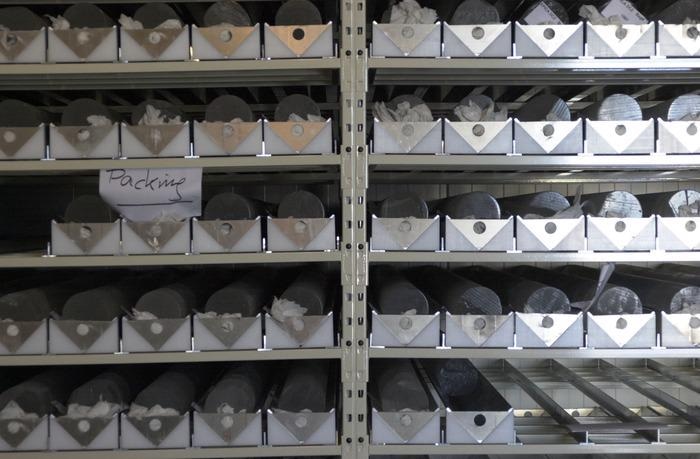Ice cores enable climate researchers to look 800,000 years back in time. Atmospheric carbon serves as fertilizer, thereby increasing biological production. The mechanism helps eliminate carbon from the air and thereby reduces the extent of global warming.
 In collaboration with Laboratoire des Science du Climat et de l’Environnement, France, the PICE team has studied the ancient air trapped inside tiny air bubbles in an Antarctic ice core. The ice core represents the last 800,000 years of climatic development. Image Credit: S. Kipfstuhl, AWI
In collaboration with Laboratoire des Science du Climat et de l’Environnement, France, the PICE team has studied the ancient air trapped inside tiny air bubbles in an Antarctic ice core. The ice core represents the last 800,000 years of climatic development. Image Credit: S. Kipfstuhl, AWI
Even under ice age conditions is it possible for plankton, plants and other life forms to increase production whenever the concentrations of atmospheric carbon rise. The mechanism can lessen the acceleration but will not avoid a continuing trend of global warming.
This conclusion is derived from an international collaboration that involves the Physics of Ice Climate Earth (PICE) center of Niels Bohr Institute, University of Copenhagen.
Global biosphere production through photosynthesis is the strongest absorbing flux of atmospheric carbon dioxide. It is therefore essential to understand its natural variability for a better projection of the future carbon cycle.
Ji-Woong Yang, Postdoc Researcher, Physics of Ice Climate Earth Center, Niels Bohr Institute, University of Copenhagen
Yang continued, “Nowadays, as we have Earth observation satellites and other advanced equipment, the mechanism of carbon fertilization is well established. However, we were not sure that the same mechanism existed in past periods where the climate was very different and atmospheric carbon concentrations much lower.”
“The new results confirm the existence of the strong correlation and allow us to model future developments with more confidence,” added Yang.
Eight Glacial Cycles are Covered
In collaboration with Laboratoire des Science du Climat et de l’Environnement, France, the PICE group analyzed the ancient air trapped within small air bubbles in an Antarctic ice core. The ice core portrays the past 800,000 years of climatic development.
The researchers take advantage of the fact that the oxygen atom does not only prevail in the most common form, 16O containing eight neutrons and eight protons but also as the isotopes 17O and 18O. The isotopic composition acts as a “tracer” for biosphere productivity. In particular, the technique will illustrate the global level of biological production compared to other methods that provide more localized results.
The scientists were able to measure the biosphere’s productivity evolution under both glacial periods (ice ages) and interglacial periods by integrating the air bubble measurements with modeling of oxygen behavior in both the biosphere and the stratosphere. As a whole, eight glacial cycles were covered.
The results clearly demonstrate that productivity drops during glacial periods and increases during interglacial periods. Further, a strong correlation exists with past atmospheric carbon dioxide concentrations measured from multiple ice cores.
Ji-Woong Yang, Postdoc Researcher, Physics of Ice Climate Earth Center, Niels Bohr Institute, University of Copenhagen
Yang added, “In addition, the effect is more prominent during glacial periods where the level of carbon dioxide and the global biosphere productivity start to increase several thousand years before the ice caps begin to melt. This correlation is explained by the strong fertilization effect by atmospheric carbon dioxide.”
Journal Reference:
Yang, J-W., et al. (2022) Global biosphere primary productivity changes during the past eight glacial cycles. Science. doi.org/10.1126/science.abj8826.